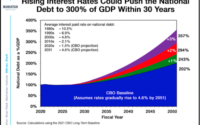Bond Yields Surge as Post-Fed Hangover Hits Stocks: Markets Wrap
(Bloomberg) — Treasury yields surged to multiyear highs and stocks fell after a parade of central banks joined the Federal Reserve in boosting rates to curb scorching levels of inflation at the expense of economic growth.
Most Read from Bloomberg
The superlatives kept piling across Wall Street as a selloff in the world’s biggest bond market sent the 10-year yield to 3.7%, its highest since 2011. The two-year rate climbed for an 11th straight session — the longest up streak in over three decades. The moves weighed on the tech space, with the S&P 500 failing to sustain a late-day rebound and moving closer to its June bottom.
The dollar remained at record levels, fueled by hawkish Fed policy and investors in search of haven. The Swiss franc slumped as a central bank hike proved not enough to satisfy expectations, while the yen gained as Japan propped up the currency for the first time since 1998.
The Fed gave its clearest signal yet that it’s willing to tolerate a recession as the necessary trade-off for regaining control of inflation, with officials forecasting a further 1.25 percentage points of tightening before year-end. Norway, Britain and South Africa also followed with hikes of their own as officials rush to get to grips with rampant price increases.
“We see this new even-higher-for-longer rate path as associated with a substantially greater higher likelihood of a hard landing, and so not just unambiguously hawkish but unambiguously bad for risk,” said Krishna Guha, vice chairman of Evercore ISI.
Read: Fed Repo Facility Use Surges to Record High as Rates Rise
Read: Mortgage Investors Jump In After Fed Says MBS Sales Aren’t Near
The S&P 500 could be poised for more downside after breaking through a rare technical indicator, according to Berenberg strategists including Jonathan Stubbs.
It has traded below its 200-day moving average for over 100 sessions — a streak that was previously breached only during the tech bubble and the global financial crisis in the past 30 years. In both of those instances, the gauge posted most of its losses after surpassing that level, with the index declining by a further 50% in 2000-2003 and 40% in 2008-2009 before troughing, they said.
Evercore’s chief equity and quantitative strategist Julian Emanuel cut his S&P 500 year-end projection to 3,975 from 4,200 and expects a “full retest” of the June low in the weeks ahead. The target cut accounts for a rising probability of a recession following Fed Chair Jerome Powell’s warning that the rate-hike process won’t be “painless” for the labor and housing markets.
Its June bottom stands nearly 2.5% below current levels.
“The bad news is we are still in one of the weakest seasonal windows of the year, especially in a mid-term year,” said Jonathan Krinsky, chief market technician at BTIG. “The good news is that it quickly reverses by mid-October. We think we test or break the June lows before then, which should set up a better entry point for a year-end rally.”
Dennis DeBusschere at 22V Research expects markets to remain volatile while maintaining his neutral, range-bound stance for stocks.
“It’s tough to get long until we get signs of slower underlying demand growth, but tail risk is limited by already tighter financial conditions, lower PEs, and higher implied vol,” he wrote.
The environment isn’t suitable for strong directional positioning on overall indexes, according to Mark Haefele at UBS Global Wealth Management. However, he advises against retreating to the sidelines, “especially given the drag on cash from high inflation and the challenge of timing a return to markets without missing out on rebounds.”
“Instead, we stay invested but also selective, and focus our preferences on the themes of defensives, income, value, diversification, and security,” he added.
Among notable corporate news, FedEx Corp. is cutting flights, deferring projects and closing offices as it seeks as much as $2.7 billion in savings to tackle challenges including slowing demand and a tight labor market. Boeing Co. agreed to pay $200 million to settle US Securities and Exchange Commission allegations that the company failed to properly disclose to investors safety issues tied to its 737 Max jetliner.
Will the Nasdaq 100 Stock Index hit 10,000 or 14,000 first? This week’s MLIV Pulse survey focuses on technology. It’s brief and we don’t collect your name or any contact information. Please click here to share your views.
Here are some of the main moves in markets:
Stocks
-
The S&P 500 fell 0.8% as of 4 p.m. New York time
-
The Nasdaq 100 fell 1.2%
-
The Dow Jones Industrial Average fell 0.4%
-
The MSCI World index fell 1%
Currencies
-
The Bloomberg Dollar Spot Index was little changed
-
The euro was little changed at $0.9839
-
The British pound fell 0.1% to $1.1257
-
The Japanese yen rose 1.2% to 142.35 per dollar
Bonds
-
The yield on 10-year Treasuries advanced 17 basis points to 3.70%
-
Germany’s 10-year yield advanced seven basis points to 1.96%
-
Britain’s 10-year yield advanced 18 basis points to 3.50%
Commodities
-
West Texas Intermediate crude rose 0.7% to $83.49 a barrel
-
Gold futures rose 0.3% to $1,680.60 an ounce
Most Read from Bloomberg Businessweek
©2022 Bloomberg L.P.
[ad_2]
Source link


